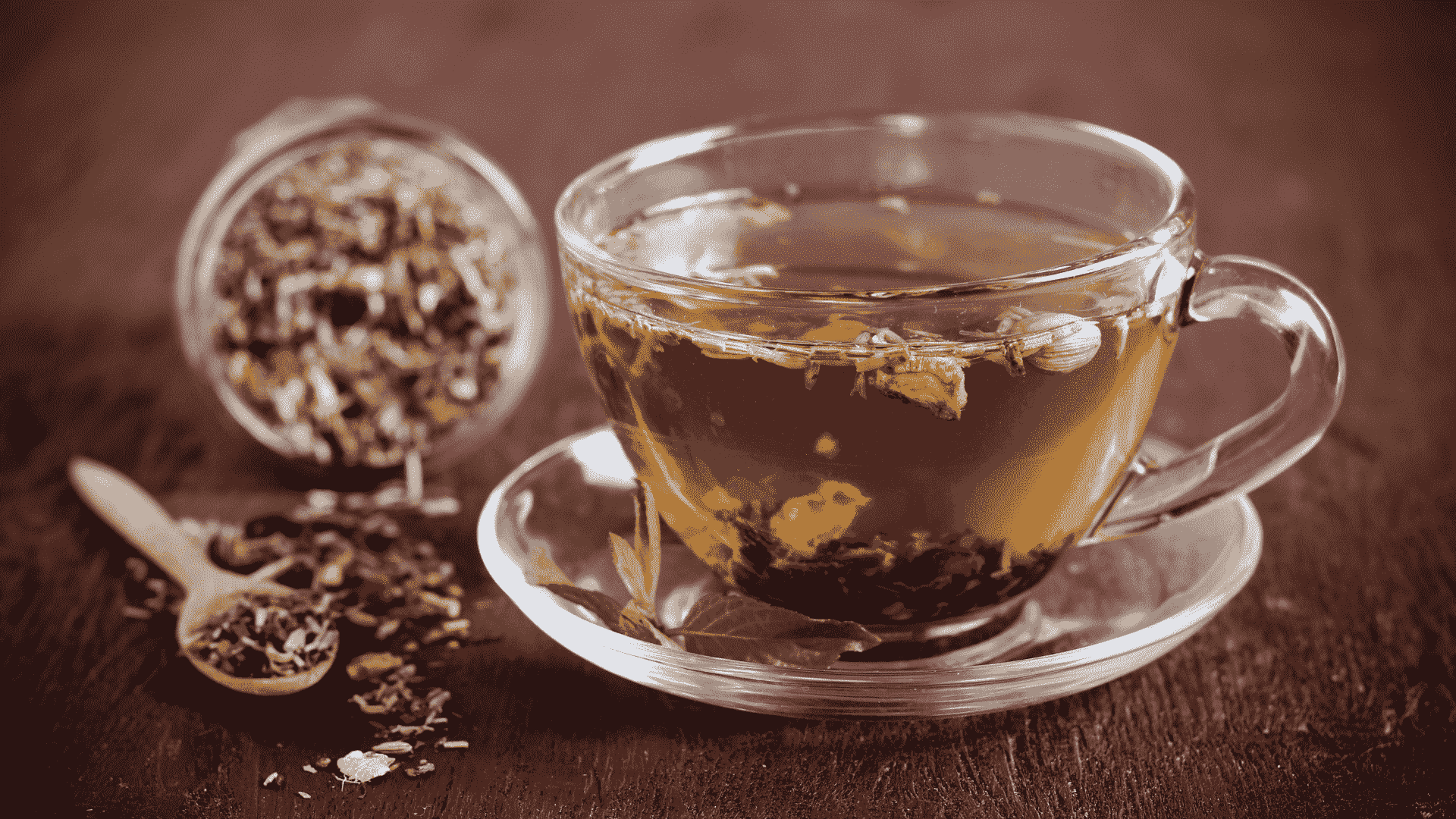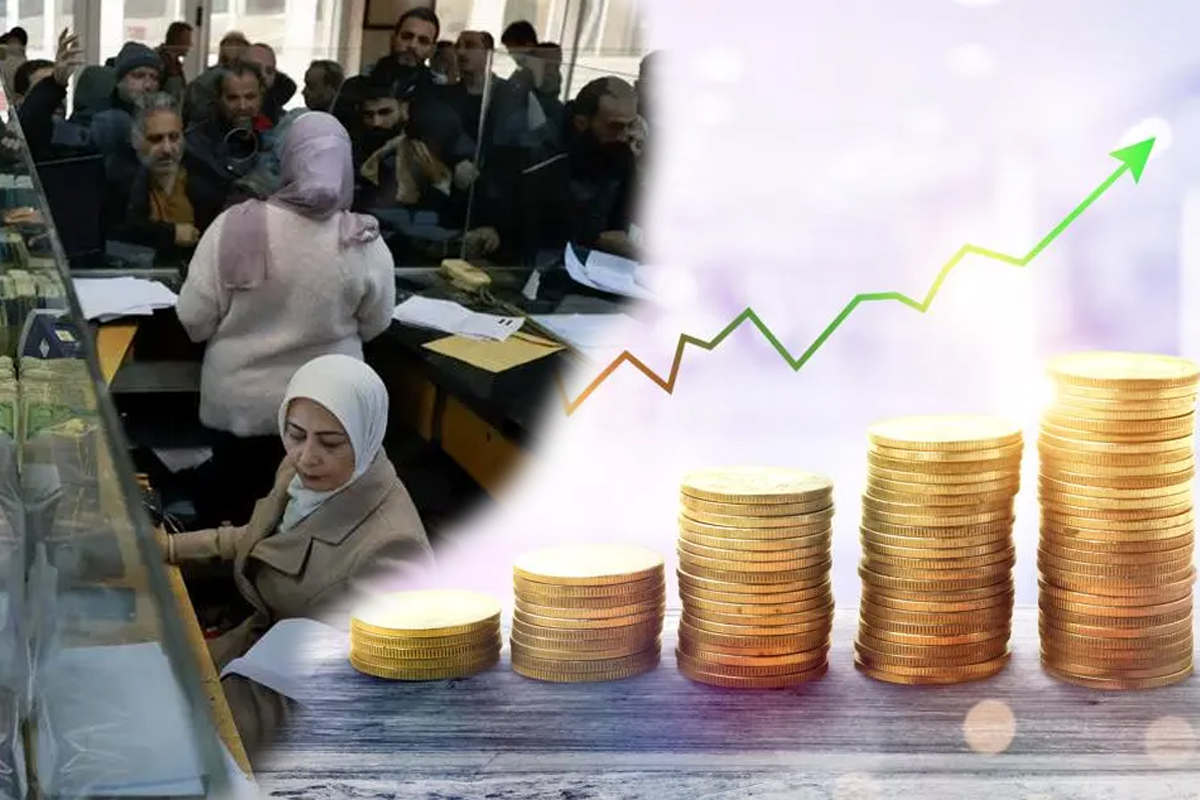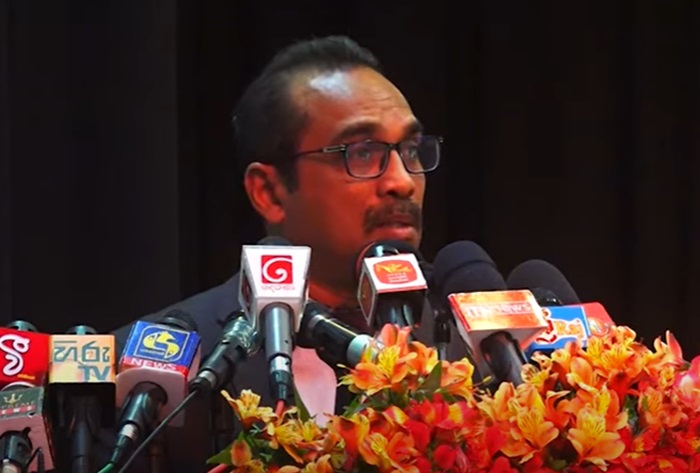.elementor-widget-text-editor.elementor-drop-cap-view-stacked .elementor-drop-cap{background-color:#69727d;color:#fff}.elementor-widget-text-editor.elementor-drop-cap-view-framed .elementor-drop-cap{color:#69727d;border:3px solid;background-color:transparent}.elementor-widget-text-editor:not(.elementor-drop-cap-view-default) .elementor-drop-cap{margin-top:8px}.elementor-widget-text-editor:not(.elementor-drop-cap-view-default) .elementor-drop-cap-letter{width:1em;height:1em}.elementor-widget-text-editor .elementor-drop-cap{float:left;text-align:center;line-height:1;font-size:50px}.elementor-widget-text-editor .elementor-drop-cap-letter{display:inline-block}
India is famous for a wide variety of teas, each with a taste and quality, beneficial to a variety of tastes and preferences.
India offers a great collection of tea choices. Assam tea has a strong malty flavor, while Darjeeling tea is known for its delicate and floral aroma.
Nilgiri tea thrives with its fruity undertones, and Masala chai appeals to the senses with its blend of black tea and spicy herbs like cardamom, cinnamon, cloves, and ginger. Because of the struggle between Britain and China, industrial tea production started in India.
Each type of tea has its special flavor and demands a particular brewing approach, which provides an exceptional experience of Indian tea.
Whether you favor a strong cup of Assam in the morning or a calming masala chai in the evening, there are many types of tea in India.
Whatever the reason, it is obvious that the broad selection of types of tea in India are available for us. In today’s blog we will some best types of tea in India.
Let’s get started!
.elementor-heading-title{padding:0;margin:0;line-height:1}.elementor-widget-heading .elementor-heading-title[class*=elementor-size-]>a{color:inherit;font-size:inherit;line-height:inherit}.elementor-widget-heading .elementor-heading-title.elementor-size-small{font-size:15px}.elementor-widget-heading .elementor-heading-title.elementor-size-medium{font-size:19px}.elementor-widget-heading .elementor-heading-title.elementor-size-large{font-size:29px}.elementor-widget-heading .elementor-heading-title.elementor-size-xl{font-size:39px}.elementor-widget-heading .elementor-heading-title.elementor-size-xxl{font-size:59px}
Historical background of tea background in India
During his mission to the Upper Brahmaputra Valley in 1823, the Scottish explorer Robert Bruce made an exciting discovery – a native tea plant. After the tragic passing of Robert Bruce, his brother Charles Alexander Bruce was charged and guaranteed that the tea received its official labeling.
He accomplished this by sending a sample of the tea to the Botanical Garden of Calcutta on December 24th, 1834.
In 1837, the first English tea garden was set up at Chabua in Upper Assam. Then, in 1840, the Assam Tea Company was founded, checking the start of commercial tea production in this part of India.
From the 1850s onwards, the tea industry noticed rapid growth, resulting in the development of huge tea plantations that covered broad areas of land.
India became a major tea producer in the 1850s, thanks to the British’s huge investment in infrastructure. India is now known as an important player in the global tea industry, famous for its variety of flavors and superior quality.
The Assam Company
The British thought Assam tea was poor. They quickly found that Chinese varieties did not tolerate Assam’s weather. London’s first joint stock tea company, The Assam Company, was founded in February 1839. After the Assam Company, the George Williamson and Jorehaut Tea Companies followed.
The East India Company
I have to say, the East India Company truly hit the jackpot in 1835 when they got their hands on some Darjeeling tea. And just a few years later, in 1841, they started growing the Chinese tea variety in the same area.
Dr. A. Campbell was liable for bringing the first seed of Darjeeling from Kumaon. Commercial tea plantations started growing in Darjeeling over the 1850s, and by 1874, a total of 113 plantations had been built.
Tea became increasingly popular during the Temperance movement in the early 19th century. It was promoted as a safe alternative to beer, as boiling water for tea ensured its safety compared to questionable water quality.
In the late 1800s, major companies like Lyons, Liptons, and Mazawattee were the leaders in the tea industry. India’s tea industry is the fourth largest in the world, producing $709,000,000 worth of tea.
Tata Company offers a combined annual turnover of approximately Rs. 13,783 Crs, with a strong presence in both the Indian and international markets. Historical financial data provides access to the last 10 years of financial data.
Tata Consumer Products Limited, formerly known as Tata Global Beverages had a market share of around 29.6 percent across India in 2016.
Top Types of Tea in India
1. Assam Tea
.elementor-widget-image{text-align:center}.elementor-widget-image a{display:inline-block}.elementor-widget-image a img[src$=”.svg”]{width:48px}.elementor-widget-image img{vertical-align:middle;display:inline-block}
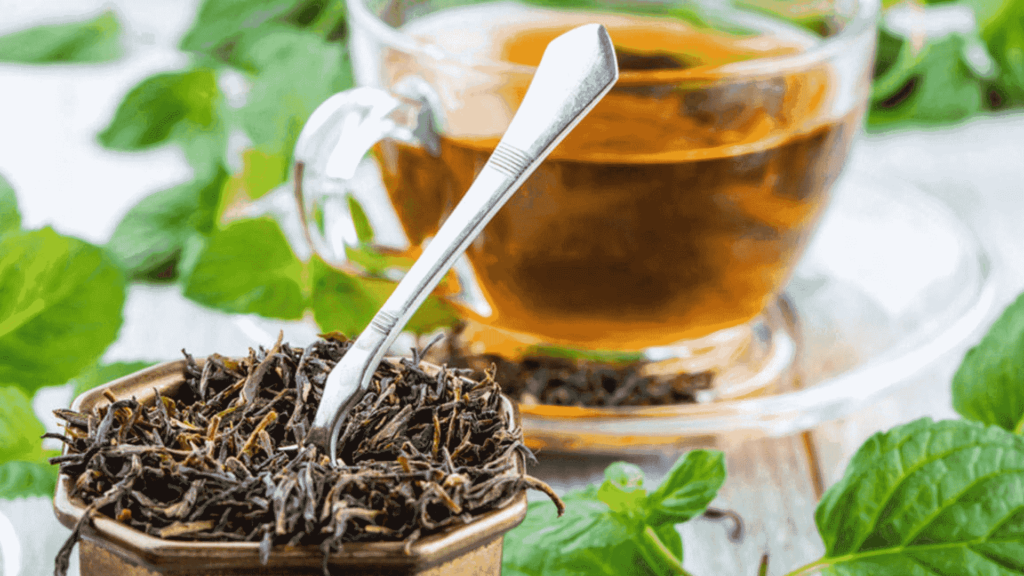
Assam, the largest tea-producing state in India, leads to over 50% of the country’s total tea production.
In 2023, Assam’s tea production reached 654.63 million kilograms, slightly lower than the 668 million kilograms produced in 2022.
Assam tea is a broadly loved variety of black tea acquired in the elegant Indian state of Assam. This tea is packed with all aspects of plant compounds that have the potential to enhance your immune system and promote the health of your heart and brain. Still, the caffeine content may not be appropriate for everyone.
Maniram Dutta Baruah, also known as Maniram Dewan, was the establishment that introduced tea plantations in Assam.
He served as the Dewan (chief administrative and financial officer) of Assam Company until he decided to set out on his own to set up his tea estate in 1841.
Yet, he was killed by the British in 1858 due to his involvement in the mutiny of 1857.
Growing Regions:
Assam tea is grown in the beautiful valleys of India’s northeast, where the Brahmaputra River flows. The region’s climate, defined by heavy rainfall and high humidity, provides the ideal conditions for growing tea.
Key Points:
- Climate: The climate here is tropical, which means high humidity and frequent heavy rainfall.
- Harvest Seasons: Assam tea is harvested twice a year – first flush (March to May) and second flush (June to August), with the second flush being prized for its robust flavor.
- Production: The leaves undergo a series of steps including withering, rolling, fermenting, and drying to develop their unique flavor.
Popular Assam Tea Brands in India: Ahmad Barooti Assam Tea, Tea India Assam Tea CTC, Tata, Assam1860, Halmari Tea, Brooke Bond Red Label
2. Darjeeling Tea

Known as the “Champagne of Teas.” I admire Darjeeling tea, made from Camellia sinensis var. sinensis and nurtured and processed in the beautiful Darjeeling or Kalimpong district in West Bengal, India.
The distinct flavor of Darjeeling tea is a result of the fusion between Chinese tea genetics and Indian terroir, along with the mindful methods used throughout harvesting and processing.
I find it to be lighter and less sharp than most black tea, yet it shows more layers and a complex flavor profile contrasted to most greens.
The limited production, labor-intensive production approach, high-quality standards, and global demand make Darjeeling tea expensive. Darjeeling tea is prized globally for its unique taste, fragrance, and quality, despite its high price.
Growing Regions:
The Himalayan mountains of Darjeeling, West Bengal, produce Darjeeling tea. The tea’s particular terroir comes from the gardens’ 600–2,000-meter heights.
Key Points:
- Taste: Delicate, light, and flowery, reminiscent of muscatel.
- Harvest Seasons: The First Flush (spring), Second Flush (summer), and Autumn Flush each have distinct flavors.
- Terroir: Darjeeling’s high height, mild temperatures, and misty climate prevent tea leaf growth, increasing flavor.
Popular Darjeeling Tea Brands in India: Twinings, Goodricke, Taj Mahal, Wagh Bakri
3. Nilgiri Tea
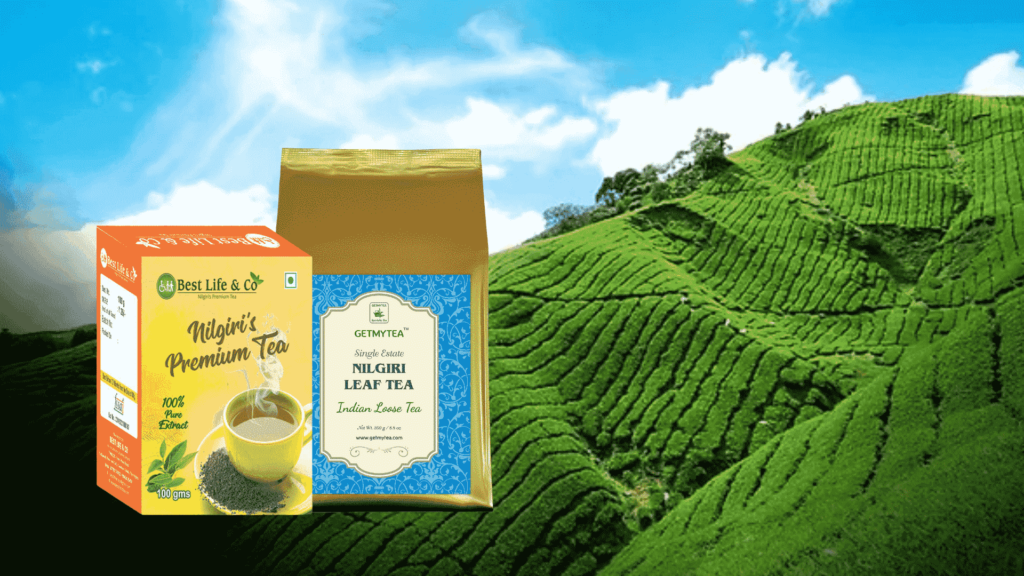
The Nilgiris district in Tamil Nadu, India, grows as well as procedures Camellia sinensis leaves for Nilgiri tea. Black tea is made from the leaves, but some estates sell green, white, and oolong tea leaves.
I appreciate the distinctive qualities of Nilgiri tea, which is known for its lively and fragrant flavors. These traits are a result of the tea’s particular growing conditions.
If you’re an admirer of tea, you’ll adore the distinctive features of Nilgiri tea. It’s often described as having a light yet full-bodied flavor, with wonderful hints of fruit like citrus and critical floral notes.
Growing Regions:
The Nilgiri Hills, or Blue Mountains, in Tamil Nadu, South India, grow Nilgiri tea. The tea gardens are 1,000–2,500 meters high.
Key Points:
- Taste: Brisk, fresh, and smooth with fruity and flowery aromas.
- Climate: The Nilgiri Hills’ cold climate and heavy humidity restrict tea leaf growth, increasing flavor and aroma.
- Production: In contrast to other places, Nilgiri tea is harvested year-round, assuring a steady supply.
Popular Nilgiri Tea Brands in India: Chamraj Tea, AVT Premium, High Range Tea, Woodbriar, Blue Mountain Tea
4. Kangra Tea
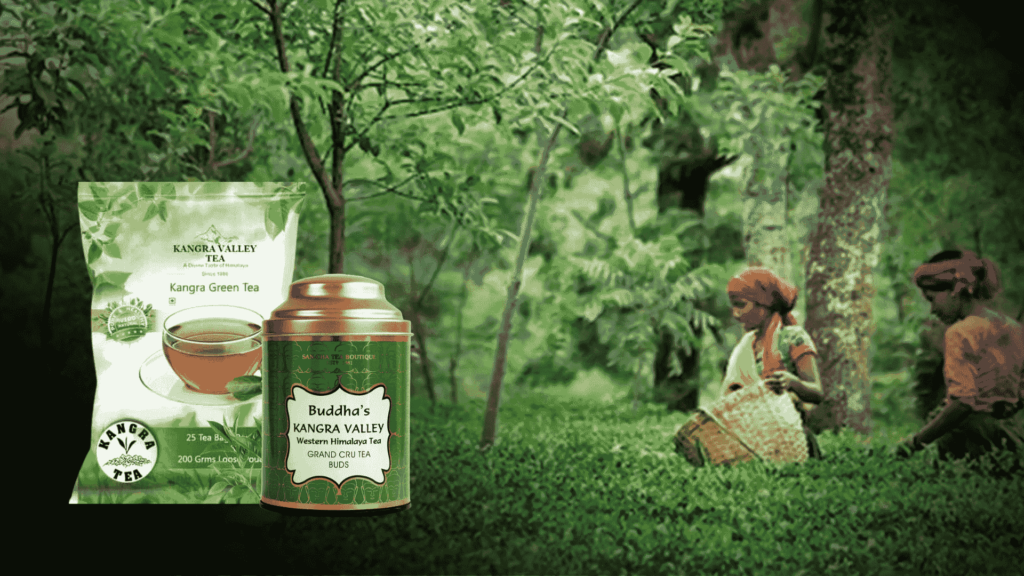
Kangra tea is a type of tea that originated from the Kangra district of Himachal Pradesh, India. Since the mid-19th century, the Kangra Valley has been the site of the growing of both black tea and green tea.
In 2005, Kangra tea was granted Geographical Indication status.
The European Union (EU) has accepted Himachal Pradesh’s Kangra tea as a protected Geographical Indication (GI), which is recognized for its quality, unique aroma, and mild fruity flavor.
Growing Regions:
Kangra tea is grown in the Kangra Valley, which is located in Himachal Pradesh, Northern India. The tea plantations are typically located at elevations between 900 and 1,400 meters.
Key Points:
- Taste: Kangra tea has a delicate aroma and a sweet, floral taste.
- Climate: The valley’s cool environment, well-distributed rainfall, and mist make tea production excellent.
- Production: Organically grown black and green teas are produced in this region.
Popular Kangra Tea Brands in India: Himalayan Brew, Manjhee Valley Tea, Dhauladhar Tea Estate, TDT
5. Masala Chai
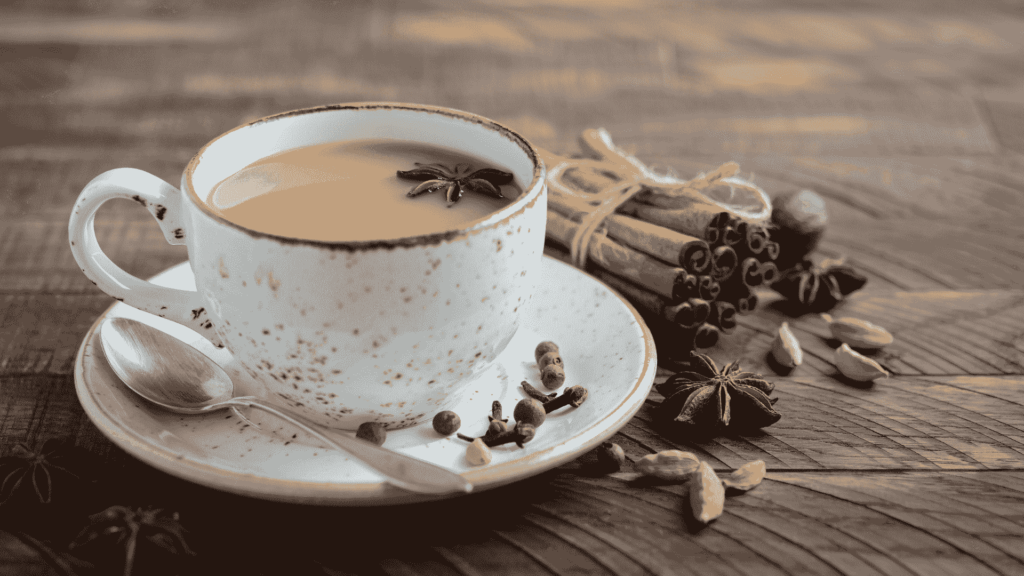
Masala chai is top famous tea in India, from the early Indian subcontinent, is popular throughout South Asia. Black tea is prepared with milk and water and sweetened with sugar.
Although tea is usually unspiced, masala chai is made with aromatic herbs and spices. Cloves, cinnamon, cardamoms, nutmeg, black pepper, and ginger are used.
Ingredients:
- 2 cups water
- 2 cups milk (or a non-dairy alternative)
- 2 tablespoons black tea leaves (or 4 tea bags)
- 2-3 tablespoons sugar (adjust to taste)
- 1-2 inch piece of fresh ginger, grated
- 4-5 green cardamom pods, slightly crushed
- 4-5 whole cloves
- 1-2 cinnamon sticks
- 1-2 black peppercorns
- 1-2 star anise (optional)
- A pinch of nutmeg (optional)
Preparation:
- Add water and spices (ginger, cardamom, cloves, cinnamon, peppercorns, and star anise) to a pot and boil. Boil and simmer for 5-10 minutes to absorb flavors.
- Black tea leaves or tea bags should be steeped in boiling water for 3-5 minutes, depending on how strong you want your tea.
- Add milk and sugar. Stir well and boil again. Reduce heat and simmer for a few minutes to mix flavors.
- Remove tea leaves and spices with a fine mesh strainer into cups. Serve hot.
Popular Masala Tea Brands in India: Tata Tea, Wagh Bakri Tea, Taj Mahal Tea, Liptan
6. Tulsi Tea
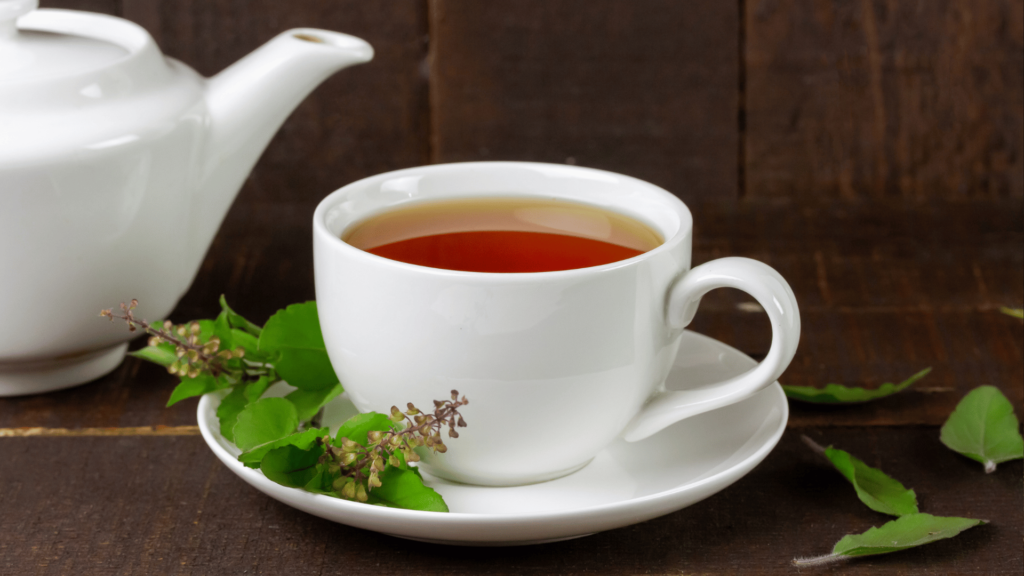
Tulsi, also known as holy basil, has been used as a religious, spiritual, and healing plant in India for more than 5,000 years. It is newer to western culture, but it is often found in herbal medicines, tinctures, and essential oils. You can also steep dried tulsi leaves to make a refreshing plant tea.
Growing Regions:
It is grown across Southeast Asian tropical regions. The tall branching shrub grows up to 60cm tall with hazy stems, fragrant purple or green leaves, and little white to purplish flowers on the branches.
Benefits of Tulsi Tea:
- Antioxidant-rich Tulsi tea boosts immunity.
- Adaptogenic Tulsi reduces stress and improves mental clarity.
- Anti-inflammatory: It reduces inflammation and pain.
- Tulsi tea supports respiratory health and relieves cold and flu symptoms.
- It aids digestion and reduces digestive disorders.
- Tulsi tea regulates metabolism and aids weight loss.
- It flushes pollutants to detoxify the body.
Preparation:
Ingredients:
- 1-2 teaspoons of dried Tulsi leaves (or 5-6 fresh Tulsi leaves)
- 1 cup of water
- Honey or lemon (optional, for taste)
Instructions:
- Boil Water: Bring a cup of water to a boil in a saucepan.
- Add Tulsi Leaves: Add the dried or fresh Tulsi leaves to the boiling water.
- Simmer: Reduce the heat and let the leaves steep for 5-10 minutes.
- Strain: Strain the tea into a cup to remove the leaves.
- Add Flavor: Add honey or lemon to taste if desired.
- Serve: Enjoy the Tulsi tea hot.
Popular Tulsi Tea Brands in India: Wellness Teas, Organic India, Basilur Tea, Ayurvedic Life, Taj Mahal Tea, Vahdam Teas
7. Irani Tea
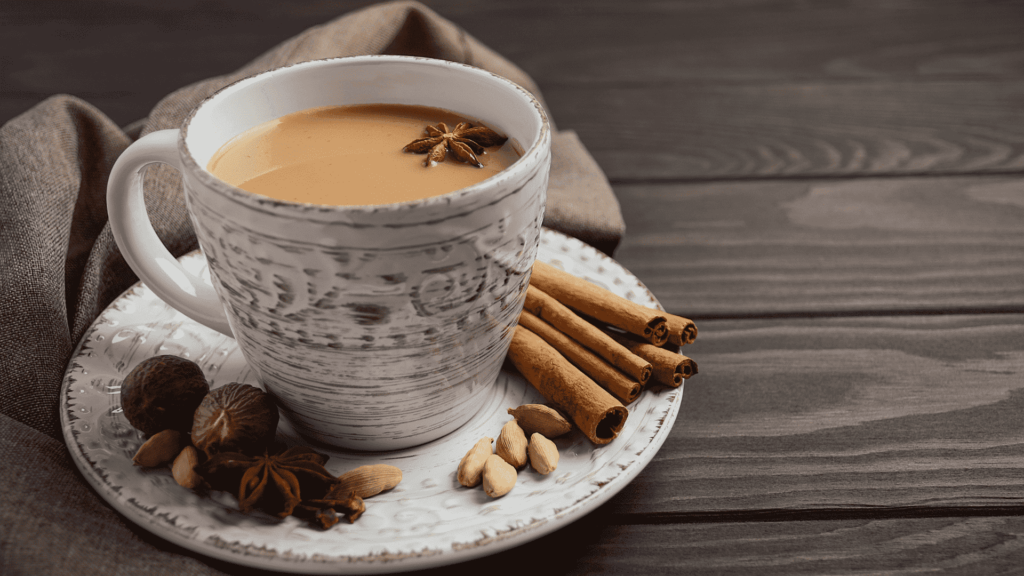
It is another famous tea in India. Popular and traditional, Irani tea, also called Irani Chai, is offered in Irani cafés across India, in particular in Hyderabad and Pune. Irani tea has gained popularity as a favorite beverage because of its unique preparation and rich, creamy taste. This is a guide on Irani tea’s ingredients, how to make it, and some well-known brands and locations.
Growing Regions:
Assam, Darjeeling, Kangra Valley(Himachal Pradesh)
Preparation:
Ingredients:
- 2 cups water
- 2 cups milk (full-fat for a creamier texture)
- 2 tablespoons loose black tea leaves (or 3-4 tea bags)
- 4-5 tablespoons sugar (adjust to taste)
- 1-2 cardamom pods (optional)
Instructions:
- Boil water.
- Add Tea Leaves: Steep loose black tea leaves (or tea bags) in boiling water for 3-5 minutes until strong.
- Prepare Milk: Boil milk in another saucepan. Reduce heat and simmer after boiling. Reducing and thickening the milk makes it creamy.
- Mix Tea and Milk: Strain tea into simmering milk, removing leaves and bags.
- Sugar and Cardamom: Mix milk and tea with sugar and crushed cardamom pods. Stir thoroughly and boil for 2-3 minutes.
- Strain the mixture into cups and serve hot.
Popular Irani Tea Brands: Hyderabad’s Famous Irani Chai, Vahdam Tea, Good Day Irani Tea
8. Herbal tea
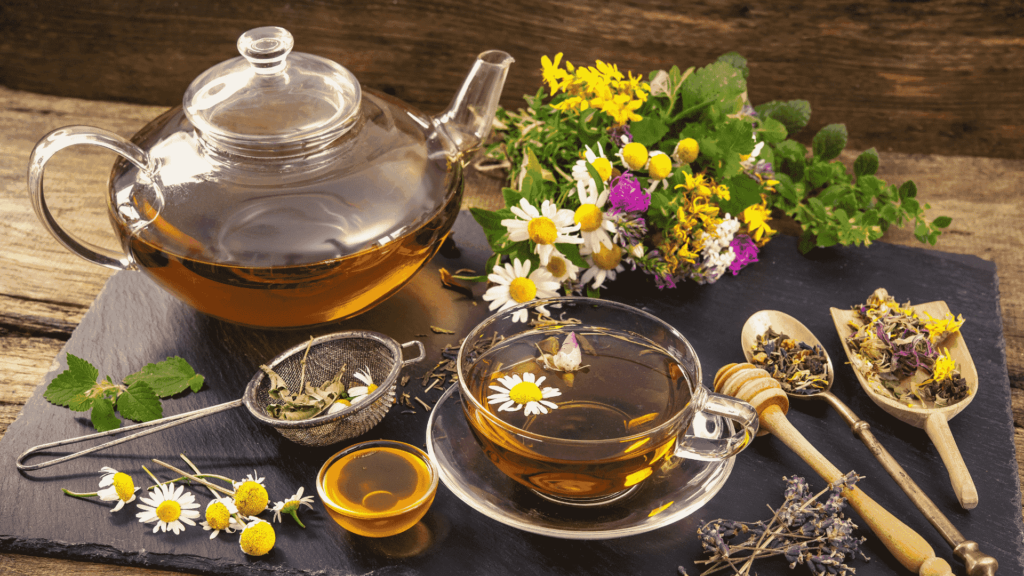
Herbal teas are generated by soaking or decocting herbs, spices, or other plant material in hot water; they are also referred to as herbal infusions and, more rarely, tisanes. Herbal tea, or simply tea, is frequently used to refer to a variety of herbal drinks. Any part of a plant, including fresh or dried flowers, fruit, leaves, stems, seeds, or roots, can be used to make herbal teas.
Popular herbal teas and their benefits:
Chamomile Tea:
Benefits: Relaxation, sleep, menstruation pain reduction, digestion.
Preparation: Steep 1-2 tablespoons of dried chamomile flowers in hot water for 5-10 minutes.
Peppermint Tea:
Helps digestion, headaches, nasal congestion, and energy.
Preparation: In boiling water, steep a handful of fresh or 1-2 teaspoons of dried peppermint leaves for 5-10 minutes.
Ginger Tea:
Reduces nausea, and inflammation, aids digestion, and promotes immunity.
Preparation: In 1-2 inches of water, boil fresh ginger root slices for 10-15 minutes.
Herbal Tea:
High in antioxidants, helps heart and skin health, and is caffeine-free.
Preparation: For 5-7 minutes, steep 1-2 tablespoons of rooibos leaves in hot water.
Hibiscus Tea:
Benefits: Lowers blood pressure, improves liver function, antioxidant abundance, and weight loss.
Preparation: Steep 1-2 tablespoons of dried hibiscus flowers in hot water for 5-10 minutes.
Lemongrass Tea:
Promotes oral health, digestion, anxiety, and inflammation reduction.
Preparation: Steep 1-2 tablespoons dried or fresh lemongrass stems in boiling water for 5-10 minutes.
Popular Herbal Tea Brand in India: Tazo, Yogi Tea, Celestial Seasonings, Organic India, Pukka Herbs, Bigelow Tea
Conclusion
Finally, these are our famous tea brands in India. India’s tea culture is both numerous and rich, giving a broad range of flavors and experiences for tea lovers. The specific terroir and historical significance of each region can be seen in the teas, which range from the robust Assam and aromatic Darjeeling to the spiced warmth of Masala Chai and the perfumed Kashmiri Kahwa.
FAQs
What are the most famous tea brands in India?
Assam tea, Darjeeling tea, Nilgiri tea, and Masala chai are the most prevalent types of tea in India.
What is Assam tea and why is it famous in India?
Assam tea is a black tea that is cultivated in the Assam region of India. It is renowned for its robust, malty flavor and is a popular beverage in India and other parts of the globe.
What separates Darjeeling tea from other types of tea in India?
In the Darjeeling region of India, Darjeeling tea is a black tea that is both light and aromatic. This tea is frequently referred to as the “Champagne of Teas” because of its refined flavor and aroma.
What separates Nilgiri tea from various types of tea in India?
Nilgiri tea is a black tea that is both aromatic and mellow, and it is cultivated in the Nilgiri Hills of southern India. It is renowned for its velvety flavor and is frequently incorporated into tea mixtures with other teas.
Masala chai is a popular choice among various types of tea in India. What is it, and why is it so popular?
Masala chai is a spiced tea that is made using black tea, milk, sugar, and a combination of spices, including cardamom, cinnamon, ginger, and cloves. In India, it is a beverage that is adored for its aromatic and comforting qualities.




